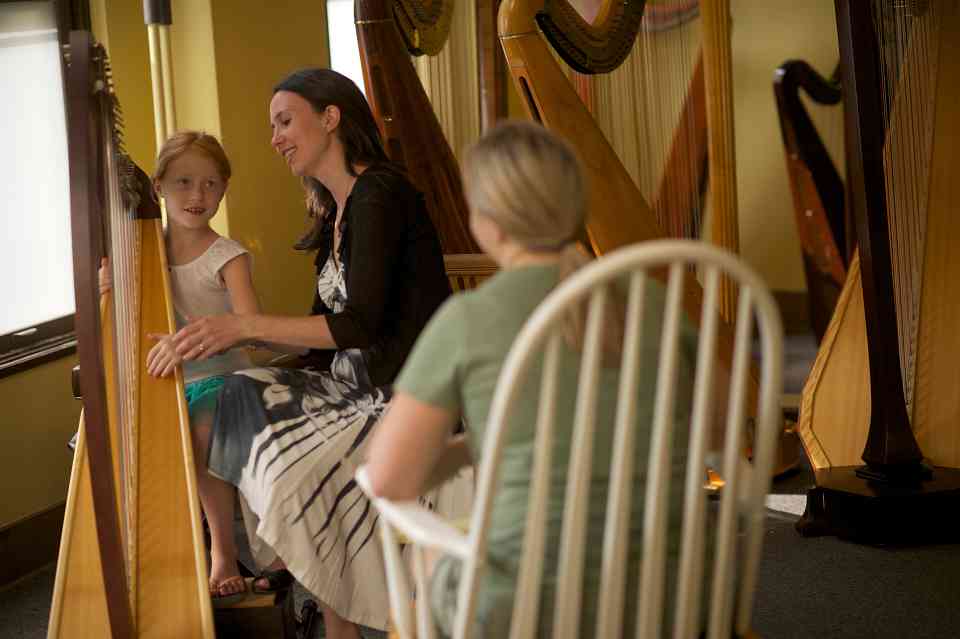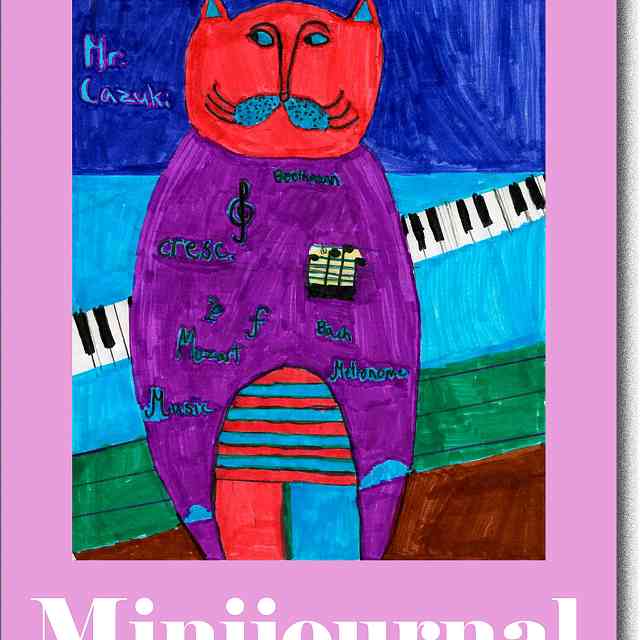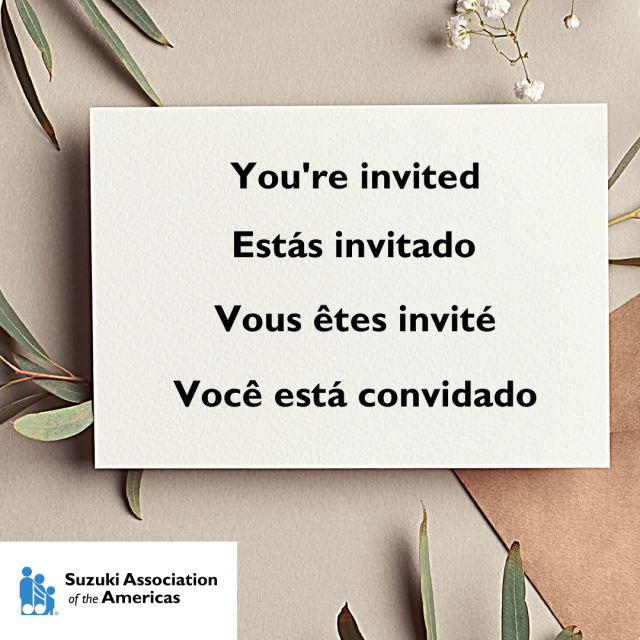
Our students look to us as models for how to play the instrument they are in the process of learning. Teachers demonstrate a student’s working piece played at a professional level with attention to beautiful tone, graceful phrasing, and technical facility. They have a living, breathing example of a human being who is listening in the moment and making music. This allows them to experience firsthand a preview of where they are headed as a musician, but it also allows them to experience the process through which a musician hones their craft in real time.
As Suzuki teachers, we have an opportunity to engage with our students in a holistic way for many years. There is indeed the musical part of the journey, where we continually listen as we play, notice what we hear, and apply what we noticed to our next attempt. But there is also the human experience part of the journey, where we continually go through the process of trying to do something new, noticing how we feel along the way, and engaging with those feelings as they come and go. I would posit that the human experience part actually requires far more loving guidance than the musical part and that the more safely guided the student feels on the human experience part of it, the easier the musical part will be.
What if we approached the emotional experience of learning with the same kind of consciousness we use to approach the teaching of our instrument? Our students look to us as models for how to play the harp, but they also look to us as models for how to be in the world. We demonstrate how a mature adult engages with difficult tasks, other people, success, failure…and we are also constantly demonstrating how a mature adult engages with the internal landscape of her own emotions. Whether we mean to demonstrate any of this or not, we are doing so in every lesson so we may as well approach this aspect of teaching with awareness and intention.
Children are extremely porous and perceptive when it comes to emotion. If an adult feels frustrated and irritated inside and acts peaceful and happy outside, the child will experience both things vividly all at once and it can be quite confusing for them. Most of the time, I find, they will push against the adult in question, trying desperately to get them to be genuine with them. This behavior can look like irrational “acting out” at first, but understood through this lens, it makes absolute sense. For example, instead of saying with urgency what she is really feeling, (which is: “Oh no! We’re going to be late! Hurry!”), a mother says sweetly and calmly, while desperately managing a turmoil of panic behind her smile, “Come on Honey Bunny, let’s find your shoes now, ok?” At that desperate moment, her daughter will likely put those shoes on her hands and start to giggle wildly. She just (intensely) wants to know how her mom really feels and she’s pushing against her mother to try to get her to be real with her. Right now.
One of the most difficult aspects of teaching is helping students understand that they can’t just skip to the final step and instantaneously play their piece the way you do. You can’t flick your magic wand so that they can suddenly just do it. You have to show them the path and break down the steps and walk alongside them as they go. They often try to skip all the interim steps anyway and kind of just fake that they’re already there, and it’s our job to bring them back to where they actually are so they can get to where they ultimately want to be.
What if we cultivate a culture of listening internally to our emotions with the same kind of acuity we apply to listening externally to phrasing or tone? What if we acknowledge that the process of learning (and teaching) comes with a wide range of feelings, just like playing comes with a wide range of sounds? What if we approach these emotions with the intention of noticing them, allowing them to be there, and then trying again just like we do in our playing?
Take this example: The student plays his scale, attempting an even crescendo. He tells us what he heard:
Student: “Soft, soft, soft, soft, LOUD.”
Teacher: “That’s what I heard, too. Way to listen to your playing.”
Then he tells us how he is feeling:
Student: “I’ve tried a bunch of times and it still doesn’t get louder evenly…this is so frustrating. Wilt.”
Teacher: “It IS frustrating to try a lot of times and have it not work yet. I get it. Way to listen to your emotions.”
Both of the things he is articulating here are absolutely fine and the adults around him can simply help him to notice them—lovingly. We can trust that the uneven crescendo will be gone as soon as the strings stop vibrating, leaving room for the next scale he plays. We can also trust that the wilty feeling will move through like the changing weather, leaving room for the next emotion to arise in him. Honestly and compassionately acknowledging both the uneven crescendo and the wilty feeling is an essential part of the authentic learning process.
Another incredibly difficult aspect of teaching is understanding that we, as teachers, can’t just skip to the final step and instantaneously work with five-year-olds the way Dr. Suzuki did. There’s no magic wand here either. And while we do have a loving Suzuki community of teachers and mentors and a rich body of literature, in our day-to-day experience, we are ultimately quite on our own to figure this out. We don’t have a weekly lesson with a sage who can teach us to be compassionate with ourselves and forgive ourselves for being messy and human—someone who can guide us through the painful experience of truly seeing ourselves as we are and loving what we see, accepting ourselves exactly where we are, and letting go of the idea that should be anywhere else right now. How often do we try to skip all the interim steps anyway and just kind of fake that we’re already there?
I used to feel like it was my job to always be positive in a lesson, even if that lesson felt like a total struggle. Now, I just level with the student in an age-appropriate way. I was working with a 12-year-old over Zoom this summer and it was hard and confusing. She was hitting her capacity for taking in information and trying more times, and I was hitting my capacity for having the thing I had just said be disregarded again. I finally just stopped and told her the truth, which was something to the effect of:
“Hey, this is getting under my skin. I have this thing where when I’m saying something to someone, but it feels like whatever I’m saying is just blowing away into nothingness…it GETS to me…and that’s happening in me now…I’m getting super anxious…I gotta breathe for a minute.”
And she looked at me the way a kid looks at an adult who has just trusted her with their real self and their real feelings. And she said something like, “I get that,” and, “I was starting to feel pretty anxious too.” And the ickiness diffused. We got a drink of water. We both tried again. The counterpoint came together.
People would often remark on how patient Dr. Suzuki was. This was true if you define patience as “feeling a sense of compassionate peace in this moment.” But Dr. Suzuki tended to shy away from that word, understanding that in most people’s experience, patience was something closer to “feeling emotional turmoil internally while attempting to appear calm externally.” To him, the word patient implied controlled frustration (see mother and daughter example above…).
From reading Dr. Suzuki’s writings and hearing the way people who were close to him speak about him, I believe that Dr. Suzuki’s sense of peace, his patience, his joy, his love…these were states of being that sprang forth from a deep and honest lifelong spiritual process of compassion and forgiveness that started internally and radiated outward. When a young child had a hard time focusing, he wasn’t feigning a sense of peaceful calm. It truly was not getting under his skin. He is quoted to have said, “Patience is the absence of expectation.” He had no expectation that this child should be able to sit still yet, so it didn’t make him frustrated.
I had an epiphany a few years ago that there really just is no should. Before, when I would work with a child who had been practicing for many months on keeping her feet still, I would find myself in an internal emotional struggle when it didn’t happen in the lesson.
She should be doing what I’m asking her to do.
I should have found a better way to reach her.
This is super frustrating but I’m a Suzuki teacher so I should not feel frustrated.
At least I’m acting pleasant and calm like I should.
I should work harder to feel as pleasant and calm as I’m acting.
I’m not really sure anymore how I feel inside, but it doesn’t really matter as long as I’m acting patient outside like I should.
These are just the surface level shoulds. These exist in the moment of teaching, but they are layered upon deeper and deeper shoulds. In the catacombs of these underlying shoulds, one is faced with the fundamental things one should live up to—how one should be as a child, how one should be as a teacher, how one should be as a striving human being—one is trapped in a paradigm where one is constantly and desperately trying to get to where one should already be while hoping to maintain the illusion of having already arrived there.
Wow. From that churning vortex of should, good luck meeting a wiggling child with any shred of authentic calm and peace. Incidentally, her feet are expressing the pressure of the situation very articulately for anyone who is listening.
Let’s try that interaction again without the should. There is no reason that this child should already be able to keep her awareness in her body focused enough to notice that her feet are moving around. There’s no reason I should have brought her to that place of awareness yet. There’s no reason either of us should feel at peace with this process of learning all the time–frustration is a natural part of the human experience. It comes and goes. And, somehow, the more accepted it is, the more it is allowed to be here, the less it actually surfaces. There is nothing that either of us should be living up to that we are not living up to. There is nothing that either of us should be that we are not already. We are just working together and noticing what is going on, externally and internally. And look! The child’s feet are still for a moment and we can both smile about that.
And that is how we both actually feel—joyful. In the throes of my should misery above, I expressed that it didn’t really matter how I felt as long as I was acting patient. But as it turns out, it does matter. A lot. You feel how you feel and so does your student. You can’t decide how you feel. Believe me, I have tried. Hard. It doesn’t work. Two people learning to do a new thing simultaneously is challenging enough. There is no need to add another layer on there that dictates how those two people should feel during that process.
An even scale and true patience are beautiful in different ways, and both are worth striving toward. You can’t get any closer to either one without first compassionately honoring where you currently are. My students are where they are in this moment–they are works in progress–and I am guiding them in their practice of listening externally and internally as they learn. I am the teacher that I am at this moment–a work in progress–and I am making a practice of listening externally and internally in every moment of my teaching. I am striving to relate authentically with my students about what I hear and to provide them a sanctuary in which they can do the same.








